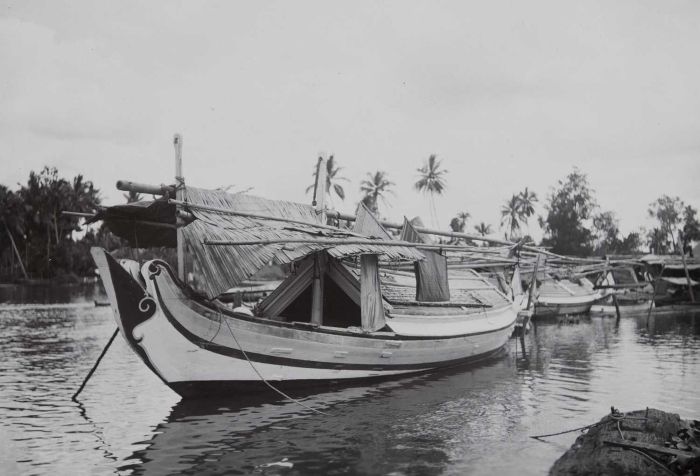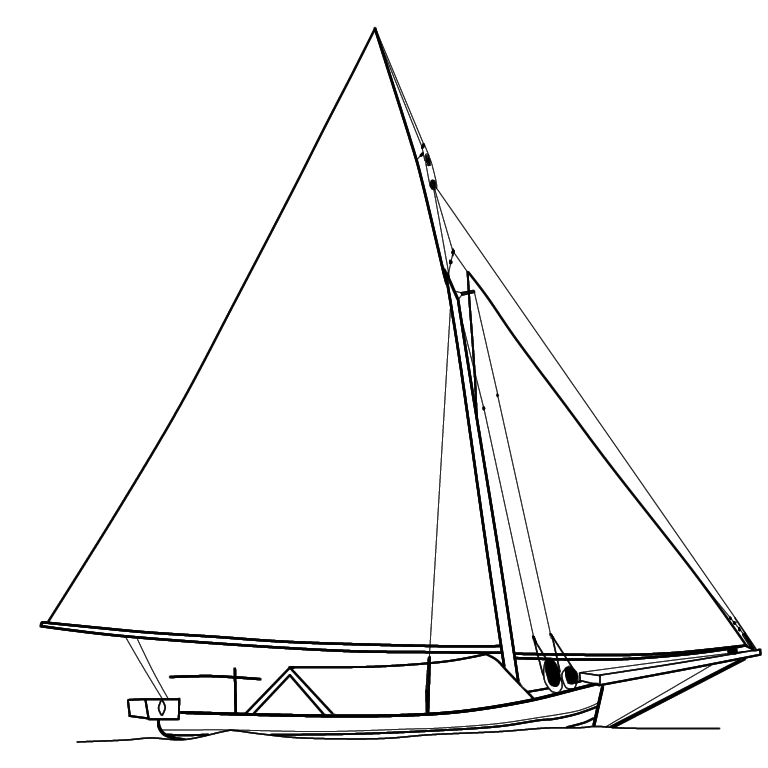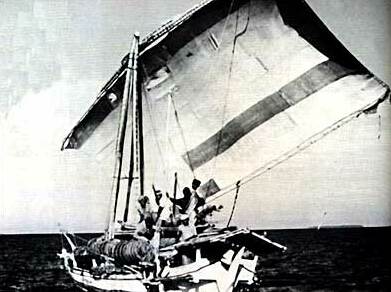|
Golekan
Golekan is a type of traditional boat from Madura, Indonesia. They once plied as far as Singapore, where they are referred to as Madurese traders. In the present this type of boat is only known locally, especially near Bangkalan in Western Madura and around the Kangean islands.Horridge (2015). p. 79. Etymology Dutch observer van Deventer wrote that it means "freight seeker". Gibson-Hill stated the name comes from Malay word ''golek'', which he claimed meant crank (tender, or 'tippy') when applied to a canoe. Rather, the name derived from ''kolek'', a Javanese word for 'boat', applied to a wide range of small craft along the north coast of Java. Thus the name ''golekan'' would meant 'a kind of ''kolek'''.Stenross (2007). p. 275. Golekan in Madurese culture were regarded as "male", being referred to as ''parao laki'' (male boat), so it has different ornamental motif from lis-alis and janggolan (''parao bini'' — female boat). The primary symbol was the rooster, associated in Indon ... [...More Info...] [...Related Items...] OR: [Wikipedia] [Google] [Baidu] |
Janggolan
Janggolan refers to two different type of ''perahu'' from Indonesia. One is from Madura, and the other from Bali. The Madurese janggolan is a type of indigenously constructed boat, meanwhile Balinese janggolan is an indigenous boat with western-styled hull construction. Madurese janggolan Janggolan in Madura comes from the western half of the south coast of Madura, from Kamal to Sampang. It is the largest from the family of boats with double stempost, like lis-alis. They can be found plying to Singapore in the past, being called "old-style golekkan". Etymology The word ''janggolan'' means transportation.Horridge (2015). p. 69. It is also called as ''parao janggol'' (meaning "transport perahu") by the Madurese. Like the alisalis, janggolan were regarded as "female" (''parao bini'' — female boat), and ornamental motif used were connected with the feminine.Stenross (2007). p. 277. Description Madurese janggolan can be identified by flat decorated face between the double stemp ... [...More Info...] [...Related Items...] OR: [Wikipedia] [Google] [Baidu] |
Lambo (boat)
The term lambo or lamba refer to two types of traditional boats from Indonesia. Butonese lambo Lambo is the Indonesian version of small western styled merchant boats with one mast from the end of the 19th century. It is directly developed as merchant boats, and unlike other boats from Indonesia, it was not derived from local fishing ''perahu'' or canoe.Horridge (2015). p. 125. Etymology The origin of the word "lambo" and its meaning is not clear. It is probable that this word is a crude dialog word meaning ''no mother", which means this boat doesn't incorporate ancestor traditions (that is, developed from Western boats). It may also be possible that, the word comes from Kawi language, Kawi (Old Javanese) language word "lambu" which means a kind of boat. Description It has two masts, with its sturdy rig and Gaff rig, gaff easily recognized from afar. The defining features of this boat is the shape of the keel, bow, and the stern (it has "counter" type stern). Most of them ... [...More Info...] [...Related Items...] OR: [Wikipedia] [Google] [Baidu] |
Indonesian Inventions
This list of Indonesian inventions and discoveries details the indigenous arts and techniques, cultural inventions, scientific discoveries and contributions of the people of Indonesian archipelago — both ancient and modern state of Indonesia. As a developing nation, currently Indonesia suffers a shortage of scientific personnel and engineers. The lack of research and development, also hampers Indonesia's comparative competitiveness. Nevertheless, despite the shortcomings, its people and government continues their efforts to advance the nation's science and technology sectors. Among other things, by promoting innovation and technology through Indonesia Science Day. Since ancient times, native Indonesians has accumulated knowledge and developed technology stemmed from necessities; from naval navigation knowledge, traditional shipbuilding technology, textile techniques, food processing to vernacular house building. Notable examples include jong, pinisi, perahu, Borobudur ship a ... [...More Info...] [...Related Items...] OR: [Wikipedia] [Google] [Baidu] |
Leti Leti
Leti leti is a type of traditional transport vessel from East Madura, Indonesia, especially from the administrative district of Sumenep. The leti leti is a recent development, the hull form and sail were developed in the 19th century. In 1979 sailing leti leti was numbered about 1000, but this was reduced in the next decades when more modern, motorized vessel appeared.Horridge (2015). p. 82. Etymology Leti leti is also known with other names and pronunciation, like leti-leti, letelete, lete lete, letek-letek, leteh-leteh, parao lete', and golekan lete. The origin of the name is unknown. In early 20th century the type was referred to in different publications as ''tekletek''. This is however the same name, with the first syllable dropped: 'le'''tek-letek'', as in 'a'''lisalis''. It may also possible that the name comes from the sail it used, the Madurese crab claw sail, or lete sail, which has just developed in the 19th century. In fact, the "lete" from lete sail is a local pronu ... [...More Info...] [...Related Items...] OR: [Wikipedia] [Google] [Baidu] |
Lis-alis
Lis-alis is a type of traditional boat of Madura, Indonesia. Lis-alis usually present in canals that provide salt evaporation service in southern part of Madura and around Surabaya. Until the present, lis-alis remained overwhelmingly popular as a fishing craft in Bangkalan and Sukolilo, while a larger version, the '' kroman'', has been used in this area for at least a century for inshore transport work. Etymology It is also known as alisalis or alis alis. The name come from Indonesian word ''alis'' which means "eyebrows". This may refer to an ornamental motif which does resemble a pair of eyebrows, often applied to the top of the bow. Eyebrows are an important aspect of feminine beauty in traditional Indonesian culture, and these boats strongly associated with the feminine — on the northwest coast they were commonly referred as ''parao bini'', which means "female boat". Description These boats come from varying size between 5 metres long to more than 10 metres. Usually the le ... [...More Info...] [...Related Items...] OR: [Wikipedia] [Google] [Baidu] |
Lis-alis
Lis-alis is a type of traditional boat of Madura, Indonesia. Lis-alis usually present in canals that provide salt evaporation service in southern part of Madura and around Surabaya. Until the present, lis-alis remained overwhelmingly popular as a fishing craft in Bangkalan and Sukolilo, while a larger version, the '' kroman'', has been used in this area for at least a century for inshore transport work. Etymology It is also known as alisalis or alis alis. The name come from Indonesian word ''alis'' which means "eyebrows". This may refer to an ornamental motif which does resemble a pair of eyebrows, often applied to the top of the bow. Eyebrows are an important aspect of feminine beauty in traditional Indonesian culture, and these boats strongly associated with the feminine — on the northwest coast they were commonly referred as ''parao bini'', which means "female boat". Description These boats come from varying size between 5 metres long to more than 10 metres. Usually the le ... [...More Info...] [...Related Items...] OR: [Wikipedia] [Google] [Baidu] |
Leti Leti
Leti leti is a type of traditional transport vessel from East Madura, Indonesia, especially from the administrative district of Sumenep. The leti leti is a recent development, the hull form and sail were developed in the 19th century. In 1979 sailing leti leti was numbered about 1000, but this was reduced in the next decades when more modern, motorized vessel appeared.Horridge (2015). p. 82. Etymology Leti leti is also known with other names and pronunciation, like leti-leti, letelete, lete lete, letek-letek, leteh-leteh, parao lete', and golekan lete. The origin of the name is unknown. In early 20th century the type was referred to in different publications as ''tekletek''. This is however the same name, with the first syllable dropped: 'le'''tek-letek'', as in 'a'''lisalis''. It may also possible that the name comes from the sail it used, the Madurese crab claw sail, or lete sail, which has just developed in the 19th century. In fact, the "lete" from lete sail is a local pronu ... [...More Info...] [...Related Items...] OR: [Wikipedia] [Google] [Baidu] |
Manggar
Manggar () is a town in the Indonesian province of Bangka-Belitung, Indonesia which is a port on the east coast of Belitung Island, and is the seat of the East Belitung Regency. The town was founded as a tin mining town in the 19th century. History In the 1860s, Dutch prospectors of the Billiton Maatschappij explored the area and established the mining district of Burung Mandi Lenggang. In 1863, a tin mine was established on the right banks of the Manggar River, and the district was renamed to Manggar district in 1866. Manggar was opened to immigration of foreign orientals on 8 October 1871, which is selected as the establishment date for the district. In late 1945, during the early stages of the Indonesian National Revolution, Dutch authorities reoccupied the town although they encountered some resistance from the newly formed Indonesian Armed Forces. After Indonesian independence, the Manggar District was one of the four districts comprising the island of Belitung by the 1980s ... [...More Info...] [...Related Items...] OR: [Wikipedia] [Google] [Baidu] |
Types Of Fishing Vessels
Type may refer to: Science and technology Computing * Typing, producing text via a keyboard, typewriter, etc. * Data type, collection of values used for computations. * File type * TYPE (DOS command), a command to display contents of a file. * Type (Unix), a command in POSIX shells that gives information about commands. * Type safety, the extent to which a programming language discourages or prevents type errors. * Type system, defines a programming language's response to data types. Mathematics * Type (model theory) * Type theory, basis for the study of type systems * Arity or type, the number of operands a function takes * Type, any proposition or set in the intuitionistic type theory * Type, of an entire function#Order and type, entire function ** Exponential type Biology * Type (biology), which fixes a scientific name to a taxon * Dog type, categorization by use or function of domestic dogs Lettering * Type is a design concept for lettering used in typography which helped br ... [...More Info...] [...Related Items...] OR: [Wikipedia] [Google] [Baidu] |
Sailboat Types
A sailboat or sailing boat is a boat propelled partly or entirely by sails and is smaller than a sailing ship. Distinctions in what constitutes a sailing boat and ship vary by region and maritime culture. Types Although sailboat terminology has varied across history, many terms have specific meanings in the context of modern yachting. A great number of sailboat-types may be distinguished by size, hull configuration, keel type, purpose, number and configuration of masts, and sail plan. Popular monohull designs include: Cutter The cutter is similar to a sloop with a single mast and mainsail, but generally carries the mast further aft to allow for a jib and staysail to be attached to the head stay and inner forestay, respectively. Once a common racing configuration, today it gives versatility to cruising boats, especially in allowing a small staysail to be flown from the inner stay in high winds. Catboat A catboat has a single mast mounted far forward and does not ca ... [...More Info...] [...Related Items...] OR: [Wikipedia] [Google] [Baidu] |
Patorani
Patorani (also prauw patorani or perahu patorani) is a traditional fishing boat from Makassar, Indonesia. It is used by Macassan people for fishing, transport, and trading since at least 17th century A.D. Historically this type of boat was used by Gowa Sultanate as war boat. Etymology The name "torani" means flying fish (Exocoetidae).Horridge (2015). p.17 Patorani can be translated as "flying fish catcher". Description Patorani fishing boat has pajala type hull with Makassar-styled rudder mounting and tripod mast. The second tripod mast is supported by the roof of its deckhouse. This boat carried wood poles as a material for fishing and basket-shaped fish traps. The sail is usually canted rectangular sail or lateen sail. Some of them had bowsprit, adorned with pieces of wool, pendants, wooden fish carving, and other decorations. If the bowsprit is not present, they are placed in the curved stempost. Patorani design remains largely unchanged for several hundred years, but someti ... [...More Info...] [...Related Items...] OR: [Wikipedia] [Google] [Baidu] |





_atau_Jabaran.png)



